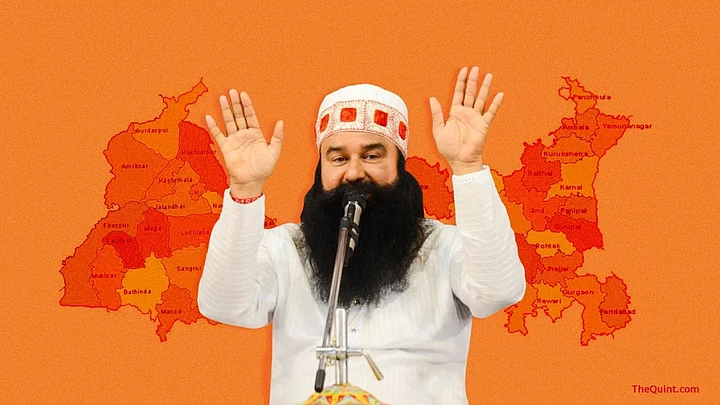The conviction and sentencing of godman Gurmeet Ram Rahim Singh of the Dera Sacha Sauda (DSS) in a 15-year-old rape case, and the large-scale violence and arson that accompanied it, leading to the death of 38 people, has suddenly brought focus on the significance of deras and the influence they wield, especially in north India.
Deras – meaning camps or congregations – number in thousands in the states of Haryana and Punjab, and many of them run counter to mainstream Sikhism. Here, we decode what and who these deras represent, and how they have come to be so popular.
What Are These Deras And Who Supports Them?
A Times of India report calls the deras "poor cousins of institutionalised religion".
Among the popular ones in north India, apart from the Dera Sacha Sauda, are Radha Soami, Dera Nirankari, Dera Sachkhand Ballan and Namdhari.
Many of them primarily derive their support base from the marginalised sections of the society – lower castes and classes – that have been sidelined by mainstream Sikhism as the latter has become the domain of the upper castes. The DSS, for instance, enjoys large-scale support from Dalit Sikhs.
The popularity of the deras in Punjab can also be seen in context of the fact that the state has a considerable share of Scheduled Caste population. In fact, the state has the highest proportion of SCs (88.6 lakh people or 31.9 percent of the state’s total population) when compared to other states.
The significance of these deras as an alternative to mainstream Sikhism is articulated by historian Babusha Maingi, who was quoted by Indian Express as saying:
By and large, these deras challenged fundamentalists (Shiomani Gurdwara Prabandhak Committee) who claim to be the protagonists of Sikhism, and restricted the membership of the heterogenous Sikh groups (particularly the non-Jats) in the Sikh institutions and organisations.Babusha Maingi, Historian
What is The Ideology of These Deras?
According to the TOI report, the ideological base of the deras is inspired from the discourses of Islam, Sufism, Sikhism, Kabir and Christianity, which are then combined with regional or local symbols and myths.
A living guru or a self-styled godman is at the centre of these deras. This is unlike institutionalised mainstream Sikhism, which does not recognise a living guru and take exception to any person being referred to as “guru” other than its ten Gurus. And instead of relying on authoritative texts or books, most of their teachings are spread orally.
These deras come up with their own spiritual-divine narratives, which run parallel to mainstream Sikhism. This has resulted in frequent tensions between the deras and the staunch Sikhs.
Why The Blind Faith in These Deras?
That the cities of Panchkula and Sirsa were packed with followers of Ram Rahim ahead of his conviction is only indicative of the immense support that the godman has been commanding.
The followers of these deras are believed to be ones who have been excluded from mainstream religion as well as state institutions including the police, the judiciary, and the local administration.
In such a scenario, the egalitarian, welfare-oriented promises of the deras, with no discrimination based on caste, are seen as making them an enticing proposition for these sections of the society.
Subsidised health services, provision of food and taking a stand against social evils such as caste discrimination, alcoholism and drugs are some of the stated objectives of the deras, which make underprivileged sections rally with them in large numbers.
Part of the social welfare work initiated under Ram Rahim's Dera Sacha Sauda was undertaking sanitation drives, organising blood donation camps, opening up a "super speciality hospital" in Sirsa, and organising flood relief work at the time of the Uttarakhand and Jammu & Kashmir flash floods.
Veteran journalist Shekhar Gupta, in his article in Business Standard, locates the mass appeal of these deras in the simplicity of the religious-spiritual practices they propagate, taking the best from both Hinduism and Sikhism. Along with this, he says the dependence of these deras on living saints reinforces the appeal of these groups.
... a holy book has much wisdom. But in times of distress, you sometimes need a human being to defer to, particularly if he has a godly reputation.Shekhar Gupta
Has Their Popularity Turned Them into Political Powerhouses?
In Punjab, the DSS supported the Congress in 2007 and then the Akali Dal in 2012.
In the Haryana Assembly polls of 2014, the DSS’ political wing Saadh Sangat Rajnitik rallied behind the BJP, and it is said that the godman’s influence in various districts of the state helped the party gain power in a number of constituencies.
The mass-following these deras command means that several of them are viewed as vote banks by political parties. The prominent deras of Punjab (Radha Soami, DSS, Dera Nurmahal, Dera Nirankari, Dera Ballan and Dera Namdhari) reportedly command influence in 56 constituencies of the state.
In the case of Dera Sacha Sauda, though the organisation has called their chief "apolitical", its participation in elections of various states – including Haryana, Delhi and even Bihar – has been significant.
While the 20-year-old prison sentence for Ram Rahim may gradually wean the influence of the Dera Sacha Sauda, the sway of the many other deras of Haryana and Punjab – offering their own versions of alternatives to mainstream Sikhism – is here to stay.
(#TalkingStalking: Have you ever been stalked? Share your experience with The Quint and inspire others to shatter the silence surrounding stalking. Send your stories to editor@thequint.com or WhatsApp @ +919999008335)
